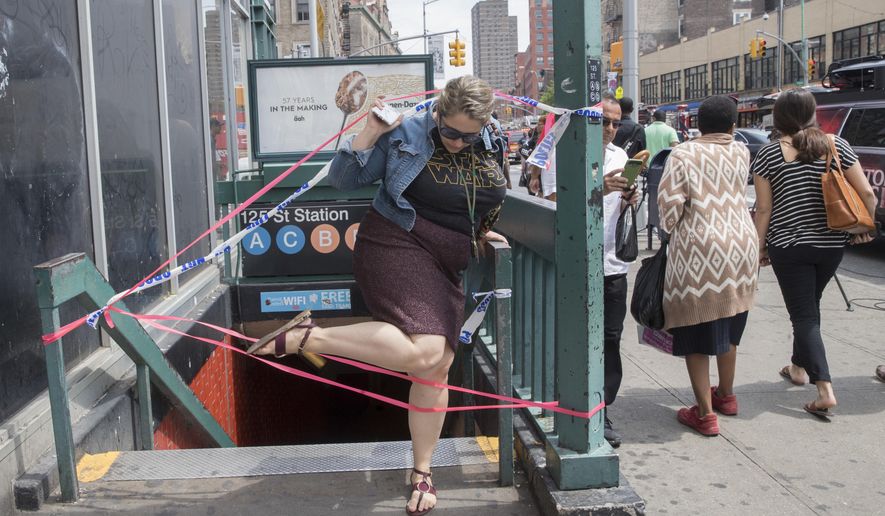NEW YORK (AP) - A subway train that derailed Tuesday as it entered a station, tossing people to the floor and forcing hundreds of shaken-up passengers to evacuate through darkened tunnels was caused by an “improperly secured piece of replacement rail” that was stored on the tracks, New York City transit officials said.
Nearly three dozen people suffered minor injuries in the derailment, which happened in Harlem just before 10 a.m.
“Storing equipment in between tracks is a common practice employed by railroads across the country to accelerate rail repairs,” the Metropolitan Transportation Authority said in a statement late Tuesday. “The key to this being an effective and safe practice is making sure that the extra equipment is properly bolted down, which does not appear to have happened in this case.”
The MTA said crews are inspecting “every inch of rail” to ensure that every replacement part “is properly stored and secured.”
Photos of the train posted on social media showed its metal side deeply scraped and dented from being dragged along the wall of the subway tunnel. Debris, including broken signaling equipment and chunks of concrete, were left in the train’s wake.
Passengers on the A train said it suddenly jerked and began shaking violently as it approached the station at 125th Street and St. Nicholas Avenue.
“We started seeing sparks through the windows. People were falling,” said passenger Susan Pak, of Englewood Cliffs, New Jersey.
Sparks from the skidding train briefly ignited garbage on the track, but there was no serious fire and the train stayed upright, said Joe Lhota, chairman of the MTA.
The derailment came after a winter and spring marked by mechanical failures, power outages and several episodes in which passengers were trapped on stuck trains for an hour or more. Some state lawmakers demanded that the Legislature take up emergency funding for the system in a special session scheduled for Wednesday.
Jack Cox, a software developer, said he felt a “large thump” and heard and felt the train grinding for as long as 30 seconds.
“During the whole time, it was just like ’What’s going on? What’s going to happen?’ Then it stopped,” he said. “I didn’t have time to be scared before then, but I looked around and the woman next to me was curled up in some sort of fetal tuck.”
Cox said smoke started coming in from one end of the car.
“It wasn’t heavy smoke, but it was frightening,” he said.
Passengers ended up walking through the darkened cars using their cellphone lights and exiting onto the platform.
Three other trains approaching the station halted in their tracks. Emergency crews shut off track power after derailments to prevent evacuees from being electrocuted.
Julian Robinson said he was stuck on one of them for about an hour before rescuers arrived to escort passengers along the tracks into the station. Pictures and video posted online showed passengers evacuating through darkened subway tunnels.
Gov. Andrew Cuomo called the derailment “an unacceptable manifestation of the system’s current state.”
“It is my expectation that with new leadership brought by Joe Lhota, the MTA will address the fundamental issues plaguing the transit system and overhaul the organizational structure of the MTA,” the Democratic governor said.
The derailment spoiled what should’ve been a bright day for the system, coming roughly two hours before the reopening of a subway station at the southern tip of Manhattan that had been closed since it was flooded by Superstorm Sandy in October 2012. The South Ferry station on the No. 1 line reopened after $340 million worth of repairs.
Lhota, who was appointed as the MTA’s chairman last week with a mandate to get the system back on track, had to skip a planned media tour of the refurbished station to deal with the derailment.
The number of subway delays has tripled in the past five years, to 70,000 per month. In recent months, several high-profile incidents have occurred, including subway trains stuck in tunnels for an hour or more. In April, a power outage backed up trains around the city and closed a key Manhattan station for 12 hours.
Commuter railroads also have had problems. A report this month found rush hour cancellations and delays on the Long Island Rail Road at the highest level in 10 years.
___
Associated Press writers Deepti Hajela and Karen Matthews contributed to this report.




Please read our comment policy before commenting.